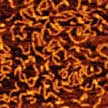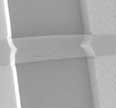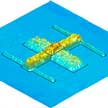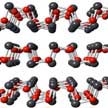Showing Spotlights 617 - 624 of 2784 in category All (newest first):
 The idea has been around for a while that selected segments of RNA or DNA could be used therapeutically to affect gene or cell function. The attraction for researchers is the flexibility that these therapeutic nucleic acids' (TNAs) versatility, programmability, and modularity affords them and shows a promising route towards treatment for a wide variety of disorders such as cancer, metabolic disorders, viral infections, cardiovascular and inflammatory diseases. Due to the programmability of RNA and DNA, scientists now are able to embed functional assemblies with controllable immunogenic potential into nucleic acid-based nanoparticles to eliminate the immune response and control the timing of their therapeutic activation.
The idea has been around for a while that selected segments of RNA or DNA could be used therapeutically to affect gene or cell function. The attraction for researchers is the flexibility that these therapeutic nucleic acids' (TNAs) versatility, programmability, and modularity affords them and shows a promising route towards treatment for a wide variety of disorders such as cancer, metabolic disorders, viral infections, cardiovascular and inflammatory diseases. Due to the programmability of RNA and DNA, scientists now are able to embed functional assemblies with controllable immunogenic potential into nucleic acid-based nanoparticles to eliminate the immune response and control the timing of their therapeutic activation.
Dec 5th, 2018
 One of the most pervasive reliability problems facing the computer chip industry is ESD (electrostatic discharging) failure caused by the rapid, spontaneous transfer of electrostatic charge induced by a high electrostatic field. A novel above-IC graphene based nanoelectromechanical system (NEMS) switch structure for on-chip ESD protection utilizes the unique properties of graphene. This switch is a two-terminal device with a vacuum gap between a conducting substrate at the bottom and a suspended graphene membrane on top serving as the discharging path.
One of the most pervasive reliability problems facing the computer chip industry is ESD (electrostatic discharging) failure caused by the rapid, spontaneous transfer of electrostatic charge induced by a high electrostatic field. A novel above-IC graphene based nanoelectromechanical system (NEMS) switch structure for on-chip ESD protection utilizes the unique properties of graphene. This switch is a two-terminal device with a vacuum gap between a conducting substrate at the bottom and a suspended graphene membrane on top serving as the discharging path.
Dec 4th, 2018
 Over the past several years, metal nanoparticles photosensitization over semiconductors with a large band gap has emerged as a promising strategy for developing visible-light responsive photocatalytic materials. In new work, researchers demonstrate a new plasmonic metamaterial can absorb nearly 100% of incident light (of a specific color) and use this energy to accelerate the production of chemicals. In constructing the near-perfect absorber, the researchers employ gold nanoparticles, TiO2 as the spacer layer, and a continuous gold thin film as the rear reflective layer.
Over the past several years, metal nanoparticles photosensitization over semiconductors with a large band gap has emerged as a promising strategy for developing visible-light responsive photocatalytic materials. In new work, researchers demonstrate a new plasmonic metamaterial can absorb nearly 100% of incident light (of a specific color) and use this energy to accelerate the production of chemicals. In constructing the near-perfect absorber, the researchers employ gold nanoparticles, TiO2 as the spacer layer, and a continuous gold thin film as the rear reflective layer.
Nov 28th, 2018
 In a groundbreaking study, researchers have successfully developed a method that could lead to unprecedented advances in computer speed and efficiency. Through this study, researchers successfully developed a method to make a version of biological patterning for nonvolatile memory technology using the M13 bacteriophage - a virus. This possibility leads the way to the nanosecond storage and transfer delays needed to progress modern computing.
In a groundbreaking study, researchers have successfully developed a method that could lead to unprecedented advances in computer speed and efficiency. Through this study, researchers successfully developed a method to make a version of biological patterning for nonvolatile memory technology using the M13 bacteriophage - a virus. This possibility leads the way to the nanosecond storage and transfer delays needed to progress modern computing.
Nov 27th, 2018
 Scientists report the experimental results of studying the response characteristics in a millimeter wave band whispering gallery mode sapphire resonator to single-layer graphene at different distances of graphene from the resonator. They found that the evanescent field of the resonance system is extremely sensitive to the environment, surrounding materials and disk coatings. A series of experiments showed that such whispering gallery mode resonance can be used to detect the conductivity and thickness of the materials deposited on top and/or can even be used for advanced biosensing.
Scientists report the experimental results of studying the response characteristics in a millimeter wave band whispering gallery mode sapphire resonator to single-layer graphene at different distances of graphene from the resonator. They found that the evanescent field of the resonance system is extremely sensitive to the environment, surrounding materials and disk coatings. A series of experiments showed that such whispering gallery mode resonance can be used to detect the conductivity and thickness of the materials deposited on top and/or can even be used for advanced biosensing.
Nov 21st, 2018
 Recently, researchers have engineered a next-generation battery technology - known as metal-air batteries - which can be easily fabricated into flexible and wristband-like cells. Although metal-air batteries powered devices still are not ready yet for commercial applications, the current studies have established solid evidence that these devices have provided enormous opportunities to develop the next generation of flexible, wearable and bio-adaptable power sources. Researchers now report a solution to overcoming the current limitation on sluggish reaction kinetics of air cathodes in Mg-air batteries.
Recently, researchers have engineered a next-generation battery technology - known as metal-air batteries - which can be easily fabricated into flexible and wristband-like cells. Although metal-air batteries powered devices still are not ready yet for commercial applications, the current studies have established solid evidence that these devices have provided enormous opportunities to develop the next generation of flexible, wearable and bio-adaptable power sources. Researchers now report a solution to overcoming the current limitation on sluggish reaction kinetics of air cathodes in Mg-air batteries.
Nov 20th, 2018
 A novel nanoscale additive manufacturing technique termed Nanotribological Printing creates structures through tribomechanical and tribochemical surface interactions at the contact between a substrate and an atomic force microscope probe, where material pattern formation is driven by normal and shear contact stresses. This technique advances the field of nanomanufacturing by providing a versatile and easily accessible method for creating complex (multi-material) nanostructures, with high precision and uniquely superior mechanical properties.
A novel nanoscale additive manufacturing technique termed Nanotribological Printing creates structures through tribomechanical and tribochemical surface interactions at the contact between a substrate and an atomic force microscope probe, where material pattern formation is driven by normal and shear contact stresses. This technique advances the field of nanomanufacturing by providing a versatile and easily accessible method for creating complex (multi-material) nanostructures, with high precision and uniquely superior mechanical properties.
Nov 13th, 2018
 In recent years, black-phosphorus-analogue (BPA) two-dimensional materials have been demonstrated to exhibit promising optoelectronic performances and distinguished ambient stabilities, holding great promise in practical applications. In new work, researchers demonstrated that ultra-small 2D beta-lead oxide quantum dots showed fast carrier dynamics and significantly high photocurrent density and excellent ambient stability. These findings hold great potential for high-performance BPA-based optoelectronic devices.
In recent years, black-phosphorus-analogue (BPA) two-dimensional materials have been demonstrated to exhibit promising optoelectronic performances and distinguished ambient stabilities, holding great promise in practical applications. In new work, researchers demonstrated that ultra-small 2D beta-lead oxide quantum dots showed fast carrier dynamics and significantly high photocurrent density and excellent ambient stability. These findings hold great potential for high-performance BPA-based optoelectronic devices.
Nov 6th, 2018
 The idea has been around for a while that selected segments of RNA or DNA could be used therapeutically to affect gene or cell function. The attraction for researchers is the flexibility that these therapeutic nucleic acids' (TNAs) versatility, programmability, and modularity affords them and shows a promising route towards treatment for a wide variety of disorders such as cancer, metabolic disorders, viral infections, cardiovascular and inflammatory diseases. Due to the programmability of RNA and DNA, scientists now are able to embed functional assemblies with controllable immunogenic potential into nucleic acid-based nanoparticles to eliminate the immune response and control the timing of their therapeutic activation.
The idea has been around for a while that selected segments of RNA or DNA could be used therapeutically to affect gene or cell function. The attraction for researchers is the flexibility that these therapeutic nucleic acids' (TNAs) versatility, programmability, and modularity affords them and shows a promising route towards treatment for a wide variety of disorders such as cancer, metabolic disorders, viral infections, cardiovascular and inflammatory diseases. Due to the programmability of RNA and DNA, scientists now are able to embed functional assemblies with controllable immunogenic potential into nucleic acid-based nanoparticles to eliminate the immune response and control the timing of their therapeutic activation.
 Subscribe to our Nanotechnology Spotlight feed
Subscribe to our Nanotechnology Spotlight feed





